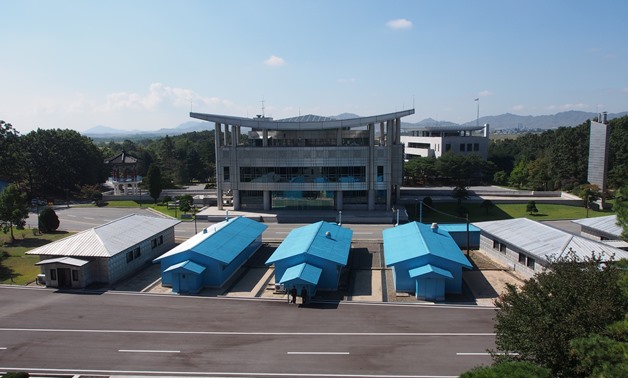
The truce village of Panmunjom - Wikicommons
There is only one place, called a truce village, where South Koreans and visitors can see the border and soldiers from the secretive state.
Panmunjom, about 55 km (34 miles) north of Seoul, is considered one of the last vestiges of the Cold War. It is located in the Demilitarised Zone (DMZ), the 4-km (2.5 mile) wide buffer that runs along the heavily armed military border.
.jpg)
The truce village of Panmunjom

The truce village of Panmunjom
The border was framed by a truce signed at Panmunjom that suspended the 1950-53 Korea War, which pitted U.S.-led U.N. forces and South Korea against North Korean and Chinese troops.
The truce village of Panmunjom has been used as the venue for the return of remains of U.S. soldiers killed during the Korean War. Nearly 8,000 U.S. personnel are listed as missing from the war, the remains of more than half of which are thought to be buried in the North.
South Korea also returned to the north via Panmunjom the remains of North Korean soldiers or civilians who had drowned and whose bodies had drifted into the south during floods in North Korea. Sometimes the North Koreans drifted alive into the south and were returned home if they wanted repatriation.
It used to be almost every Wednesday that photographers from international news agencies based in South Korea visited the truce village of Panmunjom to cover events there. Now we only go to the border village around once a month.
Usually closed circuit television cameras from both Koreas monitor the area. However soldiers from the North and South face off, sometimes very closely, when there are tourists, visiting state leaders or media representatives at the truce village. Military talks and Red Cross talks have been held there. Thousands of tourists a year visit the village to see the Cold War’s last frontier.
.jpg)
The truce village of Panmunjom
It takes only 45 minutes to drive from central Seoul to the truce village. Activists from anti-North Korean civic groups sometimes gather to send balloons carrying anti-Pyongyang leaflets toward North Korea from just south of the restricted border area, only a few miles away from Panmunjom.
Pictures of soldiers from both Koreas standing guard at Panmunjom are used frequently by media clients, especially when there are stories on tension between the two Koreas. North Korea is believed to have produced about 50 kg (110 lb) of plutonium, which experts say would be enough for six to eight nuclear weapons. It has conducted nuclear tests twice. South Korea, while a major user of nuclear power, does not have a nuclear arms program. Its U.S. ally has promised protection under its “nuclear umbrella”.
North Korea has 1.19 million troops in active service, and more than 7.7 million reservists among a population of 23.4 million, making it one of the world’s most militarized countries. South Korea, with a population of 48.7 million, has 650,000 troops on active duty and about 4.5 million reserve forces.
South Korean aid to the North was stopped after conservative President Lee Myung-bak took power in 2008, demanding Pyongyang first give up its nuclear ambitions. It was the start of tense relations between the two rivals after a decade of exchanges and steps toward peace. Pyongyang’s nuclear arms program is believed by activists to be the starving communist country’s last desperate attempt to shelter its regime from the outside world.
South Koreans must seek permission from their government to enter the North as the two Koreas are still technically at war, with the Korean War ending in an armistice rather than a peace treaty. However there is one place people can cross the border without special permissions or visas. This is a blue building called the Military Armistice Commission (MAC) Conference Room, where visitors can briefly step into North Korean territory and see the South from the North.
.jpg)

.jpg)
Comments
Leave a Comment